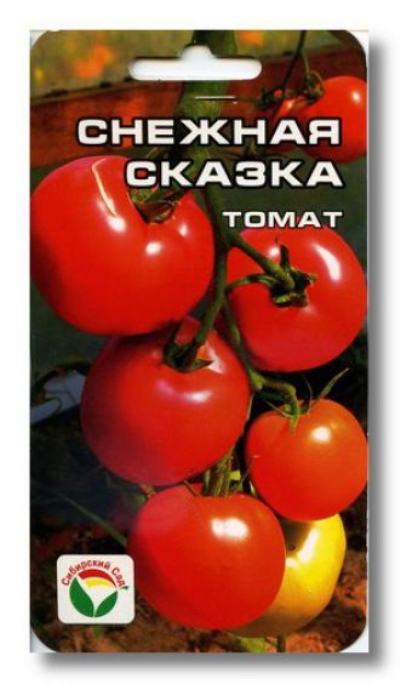
- Authors: Dederko V.N., Postnikova O.V.
- Year of approval: 2006
- Category: grade
- Growth type: determinant
- Appointment: fresh consumption, for pickling and preserving
- Ripening period: mid-season
- Growing conditions: for open ground
- Bush size: undersized
- Bush height, cm: 50-70
- Stem: thick, strong
Tomato Snow Tale belongs to the unique achievements of breeders-practitioners, which was created specifically for growing in areas with unfavorable climatic conditions. This variety is distinguished by its short stature, as well as the universal purpose of the fruits, which can be used both for fresh consumption and for canning.
Description of the variety
The unpretentious tomato Snow Tale was bred at the Novosibirsk Scientific Institute by breeders-practitioners Dederko V.N. and Postnikova O.V. It was these scientists who made the maximum amount of effort to create a universal variety of nightshade, which is able to form a rich harvest even in regions with unfavorable climatic conditions. In 2006, tomatoes were officially registered in the Russian State Register of Breeding and entered retail chains. The plant has a high yield share throughout the entire West Siberian economic zone, even if grown in open areas.
The high-yielding variety belongs to the determinant species. The average height of an adult plant is 50 cm, and under favorable weather conditions, a powerful central stem can stretch up to 70 cm.This property of the variety indicates its belonging to the standard species, and its trunk not only has a strong structure, but also a stiff bark and an ultra-compact root system. The bushes have good foliage and a dense arrangement of medium-sized leaf plates. The surface of the rich green leaves is wrinkled and uneven.
The type of inflorescence is simple. Sepal without articulation. The first brush is formed after 6-7 leaves. This variety is distinguished by the formation of a large number of ovaries, the percentage of which does not decrease even after exposure to late frosts.
The undersized variety does not need not only to be attached to the central support, but also to remove the side stepchildren, which significantly reduces labor costs during its cultivation.
The main qualities of the fruit
The fruits of the Snow Tale tomato have a rounded spherical shape with an average weight of about 55 grams. However, you can often see specimens, the weight of which reaches 150 grams. One mature fruit contains about 4 seed compartments.
The skin is dense with a glossy sheen. The pulp is firm, fleshy and oily.
Taste characteristics
The versatile fruit has a balanced tomato flavor. Juicy and sweet tomatoes have slight sour notes. Due to their excellent taste and their juiciness, tomatoes are successfully used both for the preparation of fresh salads and for canning in various forms.
Ripening and fruiting
A mid-season tomato is distinguished by the formation of a large number of fruits. The mass harvest takes place at the end of July and beginning of August. Ripening of the first tomatoes occurs 105-110 days after the appearance of the first shoots. The fruits reach the stage of technical maturity at 85-90 days, acquiring a beige-green hue. Ripe fruits have a deep red hue.
Fruit ripening is uneven and lasts more than a month. This feature leads to the fact that the bushes look very bright and unusual. To many, they resemble little Christmas trees.
Despite the universal qualities of the fruits, their storage period does not exceed 1 week, which negatively affects their transportation.
Yield
Tomato Snow Fairy Tale refers to high-yielding mid-season varieties. One small bush is capable of forming up to 30 fruits. From a plot of 1 hectare, you can harvest up to 285 centners of the crop.
To increase yields and increase the mass of fruits, breeders recommend removing several inflorescences in a formed bunch.
The timing of planting seedlings and planting in the ground
Given the fact that this variety is intended for regions with unfavorable climatic conditions, it is best to grow them in seedlings. Sowing seeds for seedlings is best done in late March - early April. It is possible to increase the germination percentage by creating greenhouse conditions. In most cases, the seedlings are strong, powerful and stocky. Breeders recommend that it must be hardened within 10-15 days.
Landing in open ground can be carried out already at the end of May, after the threat of the last frost has passed. Plants of this variety have the unique ability to quickly recover after short exposure to low temperatures.

Growing tomato seedlings is an extremely important process, because it largely depends on whether the gardener can harvest at all. All aspects must be taken into account, from seedbed preparation to planting in the ground.
Landing scheme
Due to their low growth, the bushes can be placed at a short distance from each other, which significantly increases the yield percentage. The optimal number of plants per 1 m2 is 4-5 plants.

Growing and care
Due to their unpretentiousness, tomatoes do not need increased attention to themselves. Low-growing bushes do not need to be fixed to a vertical support and pinned. However, a large number of ovaries can provoke deformation of the bushes, so in this case it is better to tie them up.
To obtain a stable and high-quality harvest, nightshades must be regularly watered, fed, loosened the root zone, removed weeds and treated from pests.




A plant needs different micronutrients at each stage of growth. All fertilizers can be divided into two groups: mineral and organic. Folk remedies are often used: iodine, yeast, bird droppings, eggshells.
It is important to observe the rate and period of feeding. This also applies to folk remedies and organic fertilizers.


Growing regions
The versatile variety is successfully cultivated in various climatic regions, but it is most popular in areas with difficult climatic conditions. Tomatoes are grown in household plots of the Altai Territory, in Kemerovo, Novosibirsk, Omsk, Tomsk and Tyumen regions, as well as throughout Siberia.

























































































